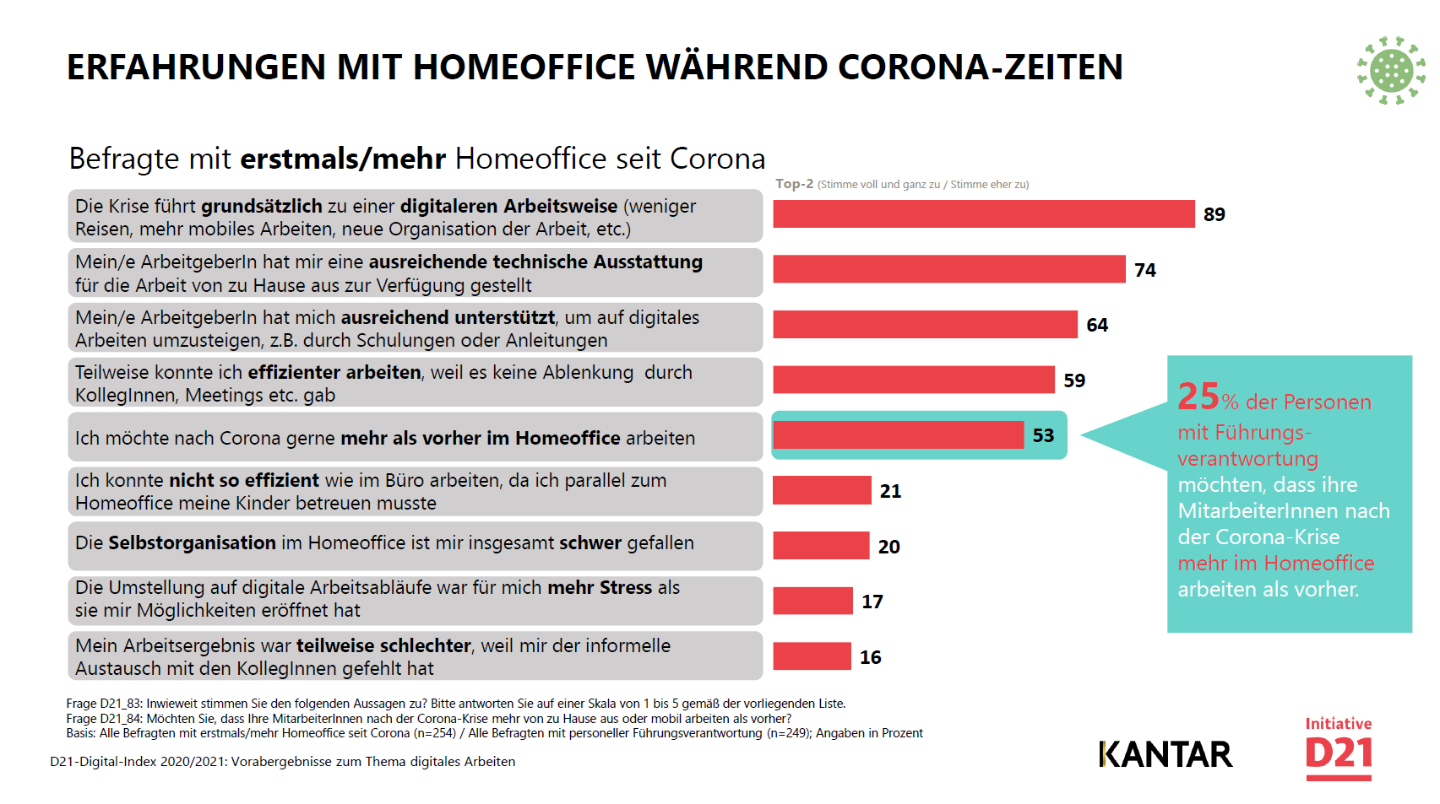What used to be a rare perk for most has become the new normal under COVID-19 – nearly one third of all employees, and almost 60 per cent of office workers, are now working remotely. Compared with last year, these figures have doubled. This is mainly attributable to the fact that since the lockdown in March, many companies have had to move their entire workforce into a work-from-home setup. For 34 percent of these employees, this is the first time they have ever had the opportunity to work from home. 38 percent are working from home significantly more than before. The experience has been so positive that 51 percent would like to continue using a digital workplace for at least half of their working hours in the future.
Working from home is more productive
Although many companies had to organize the transition to working from home in a rush, they seem to have done it well. 74 percent of the people surveyed for the 2020/2021 D21 digital index study said that their employer had provided them with the technical equipment that they needed to enable them to work from home. Additional support was provided in the form of training courses introducing employees to the digital work environment.
Working from home helps employees to achieve a better work-life balance, making it easier to combine professional and family commitments, and saving time that would otherwise be spent commuting. Companies are also reaping noticeable benefits: 59 percent of respondents indicated that they work more efficiently at home than in the office – for example, because they are not being distracted by colleagues. This confirms the high figure identified in the findings of a special analysis that was carried out for a report published by the health insurance provider DAK in April 2020.
In light of these findings, it is surprising that only one in four managers is in favor of their employees working from home more after the COVID-19 crisis, meaning that 75 percent are opposed to the idea. It seems that the transition to a more modern working culture with a digital mindset has not reached the higher levels of the hierarchy yet. But a change in the corporate culture is a necessary prerequisite for a successful digital transformation. Managers play a critical role in this transformation by raising their employees’ awareness of the opportunities and challenges of the digital age, involving them in the process, and encouraging them to be open to changing structures and processes and expanding their digital skill set. It takes managers who genuinely believe in the benefits of a modern working culture, practice this culture authentically, and thus lead by example.

Source: D21-Digital-Index 2020/2021
Now is the time for sustainable concepts
There will be no going back after the pandemic. The digital workplace will become a lasting alternative to being physically present in the office. In order to make this work, companies will need a comprehensive and sustainable digitalization strategy. This includes technologies and platforms that enable employees to work in a flexible and secure manner – irrespective of their location, including at international level. According to the D21 digital index study, the provision of laptops (49 percent) and smartphones (23 percent) has barely changed during the pandemic (up by 3 percentage points and 1 percentage point respectively). But a very different picture emerges with regard to collaboration tools (up by 15 percent), video conferencing services (up by 17 percent), and VPN clients (up by 17 percent). However, due to the enormous time pressure, many companies have implemented isolated solutions and applications that do not feed into central data streams or fail to properly address the needs of their end users. In order to create the digital workplace culture for the post-pandemic world in the best possible way, hardware and software needs to be reviewed now to assess what is missing or requires adaptation. It makes sense to commission an external, independent technology management service provider such as CHG-MERIDIAN to carry out this task. This partner can help to carefully assess which devices and software tools are most suitable for the defined objectives and most favorable in terms of financing conditions.
CHG-MERIDIAN is again a partner of the D21 digital index study. The D21 Initiative is Germany’s largest nonprofit network for digital society, consisting of representatives from trade and industry, politics, academia and civil society organizations. It was founded in 1999 with the aim of preventing a digital divide in Germany. Every year, it conducts a large-scale social study, the D21 Digital Index, to ascertain the degree of digitalization in German society.


